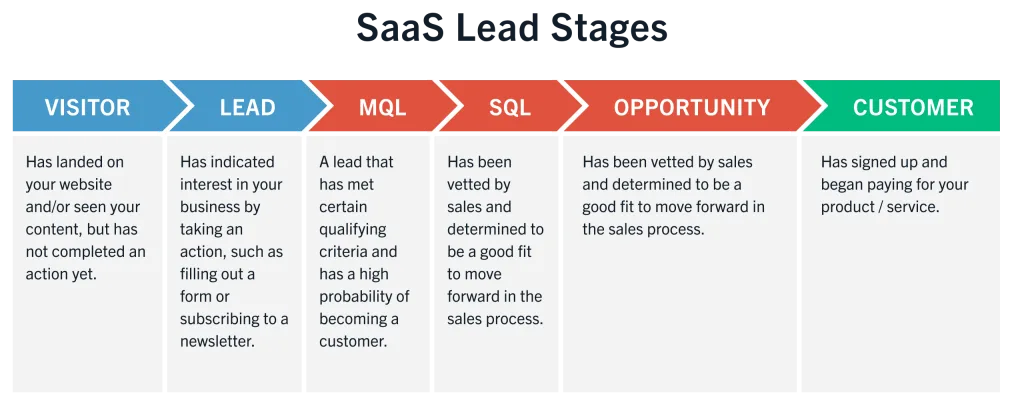SaaS marketers are always chasing after more.
More form fills, more webinar attendees, more event sign-ups, more demo requests…
What do all of these things have in common?
Each one of these actions equates to a lead. Some of them will turn into marketing qualified leads (MQLs), then sales qualified leads (SQLs), and eventually, paying customers.
But it’s never that simple, right?
The SaaS buying journey is one that’s littered with obstacles. The time between when a prospect learns about your solution to the moment they fill out a form could be weeks, even months. From there, it could be even longer until they’re exposed to enough additional touch points to finally agree to talk with a member of your sales team.
To complicate things further, not all MQLs are equal in terms of quality.
Someone who tunes into a webinar for five minutes doesn’t show the same level of buying intent as someone who requests a demo. One of these is much closer to revenue than the other, making that lead significantly more valuable.
This poses a problem for marketing teams that are primarily focused on generating MQLs. The person who attended your webinar might not be ready for a sales call anytime soon. But you still need to generate those MQLs to hit your goals, so you continue to focus your efforts on activities that drive “qualified” form fills.
But if those form fills don’t turn into revenue somewhere down the line, how effective can your marketing really be?
In 2017, Gartner’s Practice VP, Todd Berkowitz, even went so far as to proclaim the MQL as dead.
This got us thinking. Is the MQL truly the most accurate measure of marketing value? Should SaaS marketers focus on SQLs instead?
Let’s discuss.
Other agencies might help you get discovered in search.
The anatomy of a MQL
To many, the MQL is a fundamental pillar of inbound marketing. If we want to unpack why it’s (potentially) problematic, then we have to break it down piece-by-piece.
By definition, a marketing qualified lead is a lead that is deemed as having a higher probability of turning into a customer. This assertion is usually based on the lead’s web behavior.
The term MQL often means something different to every company. What’s generally true for most organizations is that for a lead to earn the title of “MQL”, it has to display a heightened level of interest.
Actions such as downloading a piece of content, viewing a specific landing page, or signing up for a newsletter are the first trigger. From there, the lead will have to meet additional criteria to become an MQL.
The qualification criteria are typically decided upon beforehand and automatically scored by a marketing automation platform or some other form of lead intelligence solution.
A big portion of this criteria includes information such as job title, company size, or any other firmographic data that would qualify (or disqualify) someone from entering your marketing funnel. These data points can be scored differently based on how much weight they hold.
For example, if your organization only sells to small businesses, then you could set up your scoring system so that a form fill from someone who works for an enterprise company would not be marked as a MQL.
Next up: the SQL
In SaaS marketing, there’s no shortage of 3-letter acronyms.
Once a lead becomes a MQL, the next step is to have it carefully vetted by a member of the sales team. Once this happens, the lead can formally move onto the next phase in the buying process as a sales qualified lead.

Similar to MQLs, the working definition of a SQL will vary from one company to the next. To ensure a seamless lead flow between the different stages, it’s imperative that both marketing and sales are aligned on what this definition is.
But unlike MQLs, the qualification process for SQLs typically happens on a call by a salesperson, instead of automatically via software. At larger organizations, this responsibility usually falls on the shoulders of a sales development team, which acts as an in-between before a lead can be passed to an account executive for a formal product demonstration. This extra step exists to maximize efficiency and ensure the potential buyer is highly qualified before moving on.
As far as qualification criteria go, this also depends on your business and ideal customer profile (ICP). One popular lead qualification framework is called BANT, which stands for budget, authority, needs, and timeline. Sales development representatives (SDRs) follow this framework to assess if a prospective buyer is the right fit to move forward in the buying process.

The problem with MQLs
The issue with MQLs boils down to two things: quality and efficiency.
A prospective customer fills out a lead form and automatically their information starts getting scored through the system. After the lead becomes designated as a MQL, it gets routed to the sales development team to be followed up with — typically within a 24-hour time frame. Once a sales development representative deems the lead ready to move forward and enter the sales cycle, then it can officially move on to the next stage as a sales qualified lead.
Although I described the MQL/SQL hand off in a few sentences, the reality looks a bit more like this:
The SDR has a handful of marketing qualified leads to follow up with each day. They go down the list and give each person a call. Some answer, most don’t. The next few days are spent following up and trying to get a hold of these people to schedule a qualifying intro call.
Out of the initial list of leads, the SDR only books calls with a few of them. Out of those few that do take a call, an even smaller number of them are ready to move forward in the sales process. From there, it’s highly unlikely that all of the leads who move forward will become customers.
The people that were unresponsive or uninterested can be placed in a marketing nurture sequence in the hopes of keeping them engaged enough to become SQLs down the line.
Of course this process might look a bit different depending on your organization and how you define MQL/SQL. But no matter which way you look at it, it’s clear that there are inefficiencies.
The other concern is quality. You could blow your MQL goal out of the water but if it doesn’t translate into SQLs, opportunities, and revenue then it doesn’t really matter, does it?
These issues can also lead to a general disconnect and lack of trust between sales and marketing teams. When you hold marketers and salespeople accountable to different metrics, even though both teams are technically responsible for the same goal of generating revenue, it creates a rift.
The case for the SQL
If the number of MQLs isn’t the best way to measure the value of marketing, then what is?
Some marketers argue that the SQL is the answer.
As a refresher, a MQL crosses into SQL territory once it’s been further qualified by a sales rep. When someone enters this stage in the funnel, they are interested in your solution and ready to be sold to.
The case for measuring marketing by SQL is pretty straightforward: sales qualified leads are closer to revenue.
Plus, this approach doesn’t discount the value of the MQL.
If a MQL isn’t ready to have a sales conversation, you still are able to throw them into a lead nurture sequence and keep them engaged until they are. Assuming your nurture program is effective, the MQLs you have that don’t convert right away should turn into SQLs eventually.
How does ABM fit into the picture?
A discussion about the relevance of MQLs wouldn’t be complete without mentioning account-based marketing (ABM).
The basic idea behind ABM is that you adjust your marketing strategy to only go after high-value accounts, thus pre-qualifying them in the process and slashing your lead to close time.

When you only market to accounts that you already know are a perfect fit, you can move away from marketing qualified leads and instead focus on marketing qualified accounts (MQA). With this approach, the number of contacts doesn’t matter as much. Most software deals require multiple stakeholders to close anyways. Instead, you’re viewing the account and its position within your funnel through a wider lens.
As more SaaS organizations move towards account-based everything, the need for the MQL/SQL hand off becomes essentially obsolete.
What’s the verdict?
The jury’s still out.
We’re not saying you should completely eliminate the MQL. That can be a very hard sell internally — especially if your executive team has relied on this metric for many years.
The Directive take: by itself, the number of MQLs isn’t enough to prove the value of your marketing activities.
But neither is the number of SQLs.
Marketing has to be measured on revenue above all else. The way you get there isn’t going to be linear, but neither is the buyer’s journey to becoming a customer.
If your focus is solely around creating marketing that generates leads, you’re missing the point. And likely creating lots of friction for the buyers in your funnel along the way.
Yes, you can and should still execute certain initiatives that are primarily focused on lead generation (i.e. free trials, run ads for demo requests, etc.) At the same time, don’t be afraid to ungate that top-performing ebook and provide value to your audience without always asking for something in return.
Buyers want to be treated like people, not form fills.
Final thoughts
There’s no doubt that this will continue to be a hotly debated topic for years to come. And like many things in SaaS marketing, the real answer is probably closer to “it depends.”
It depends on how your organization defines a “qualified” lead, the length of your sales cycle, and how strongly aligned your sales and marketing teams are.
For some software companies, this could mean a combination of different metrics that are all tracked and measured via multi-touch attribution modeling. For others, it’s fully adopting the ABM-based model.
Instead of banging the gavel one way or another, we hope this invites you to think deeper about the metrics you’re accountable for and how they drive real business outcomes. After all, the status quo is meant to be challenged.
Other agencies might help you get discovered in search.